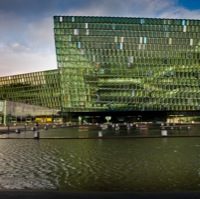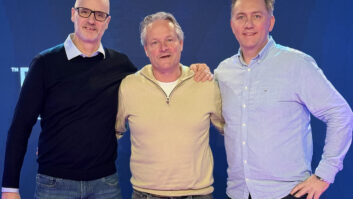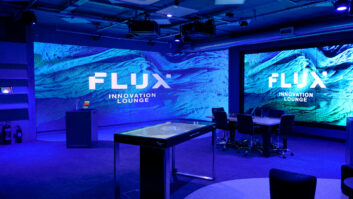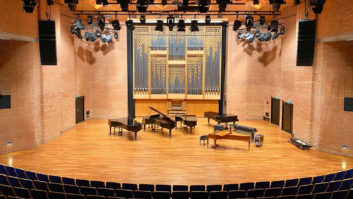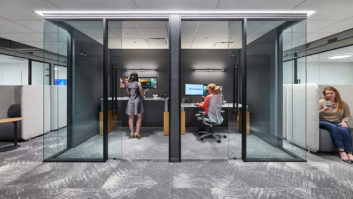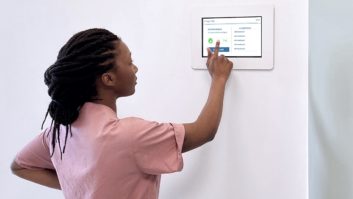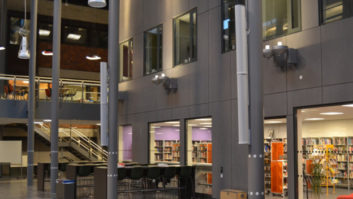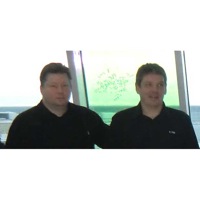
You originally founded Exton [Gunnar] and Kastljos [Kristjan] in 1992. What were you doing immediately before that?GG: I did work for Icelandic Opera as a lighting technician, I toured with some bands and did set-up work for concerts as a freelance, I worked as an electrician for some time, and I studied electrical repair work.KM: I was working in a large club/live venue as technical director for a couple of years. My company started up as a part-time gig for the first couple of years until we built up some stock and some projects.
Was it an easy decision to set up your own companies, or was it a leap of faith? GG: It was relatively easy – at that time, almost 20 years ago, there wasn’t a rental market. I had my own lighting system, and my business partner had a system as well. We did some of the bigger concerts together. In many ways it was a natural step to set up a company to handle imports of equipment and so on.KM: When we started, the rental market was totally undeveloped – all the equipment available for rental was a few par cans and a couple of smoke machines. It was a part-time gig at the start: it took five or six years before a proper company could become viable. In that time I left the live venue and started working for television as a lighting director and a studio technician. So when did the installation work really start to take off?KM: In 1998, Kastljos got its first installation job – I was asked to design an installation for the world exposition in Lisbon that year, handling all of the technical installations for the Icelandic Pavilion. Then in 2000 when we merged Exton and Kastljos, we decided this was now a viable market and we should spend quite some time on it. So we formed a separate division to take care of installations – and spent the next seven years working towards being able to handle the national concert hall project, which was in our sights for almost 10 years. If I understand correctly, you’re not the biggest audio/video/lighting company in Iceland, but you’re the most diverse.GG: We have different competitors depending on what we do. In rental there are three other companies: one does sound and light, and some video; one does lighting and video; the third does video and audio. One of them is a division of a large IT company with a total of around 400 people. They’re our biggest competitor in audiovisual installation as well as in rental. How would you say the world of installation has changed in your time with the company?GG: It’s changed a lot. In the beginning, we hardly did any installation – it was mostly boxes sales, with maybe installing a few lights for a school. After we started focusing more on installation, we started to do installations in stores, schools, lecture halls, corporate offices and meeting rooms, and just let it grow. At the peak, we did some crazy installations – some people’s ideas were through the roof! A few years ago, for example, we put an AMX control system into a power company’s foyer that pumped water through a clear acrylic ball, maybe 1.8m in diameter. It also had lights around it to show the phases of the moon. The water level in the ball mimicked the water level in one of their hydroelectric reservoirs up in the mountains. Controlling a constant flow of water was rather different from a regular AV installation. Is Harpa the biggest project you’ve worked on?GG: Yes – by far. The project we did before this – the Hof theatre in Akureyri, in the north of Iceland – that’s about one-third of this project in value. KM: This is the biggest project of this kind in Iceland since 2000, when the state TV broadcaster moved into a new building. Has the type of sector that you work in changed over the years?KM: Besides theatres and concert halls, we have also do a lot of meeting rooms and boardrooms, plus we have done quite a few museum installations in Iceland – as well as in Paris and London.GG: If you look back over 15 years, it has gone in cycles. Because we work in a lot of sectors, we have been relatively stable, because when one area of the business goes down, another one goes up. Installation into corporations basically died around 2008-09 – it’s only just started to come back, but on a much smaller scale. You have a policy of using higher-end brands. Has that always been your policy or has it developed over the years?KM: I would say it’s been our policy all the time. We’ve strayed from it every now and then, but usually find it’s best to stay with this strategy because if you start selling cheap knock-offs and things like that, the margins are very slim and you spend more time servicing, rather than selling the next project. For instance, one of the theatres in Reykjavik has 30-year-old Meyer Sound speakers that still function properly. So we think it’s important to use proper equipment. Also, because we’re in the middle of nowhere, you can’t call for spares easily. It can take a couple of days if the person at the other end is willing and able – otherwise it takes a long time. I suppose the timing of the Harpa project was quite lucky, as it saw you through a couple of years when there wasn’t much else around.KM: It helped quite a lot. It would have been hard to survive 2009-10 without having this on hand – simple as that. We had to reduce our staff numbers by more than a third. So this project meant a lot – even though there was a period when it wasn’t certain that it would be completed. Do you have any unfulfilled ambitions – either for the company or for yourselves personally?GG: At the moment we’re looking more abroad for new projects – there are not going to be any big projects in Iceland for the next few years at least. We’ve already won a contract in Aalborg in Denmark, and we’ll keep looking for similar projects in television. We can adapt, so we’re not stuck with one thing. KM: On a personal level, I can’t think of anything. I like spending time in the office – this is a passion, that’s the only way to do things like this. I’m not a nine-to-five guy, that wouldn’t work for me. We put a lot of ourselves into our systems and our projects – you can’t get good results unless there’s some kind of passion involved in it. You could get an OK result, but you won’t get a perfect system.
